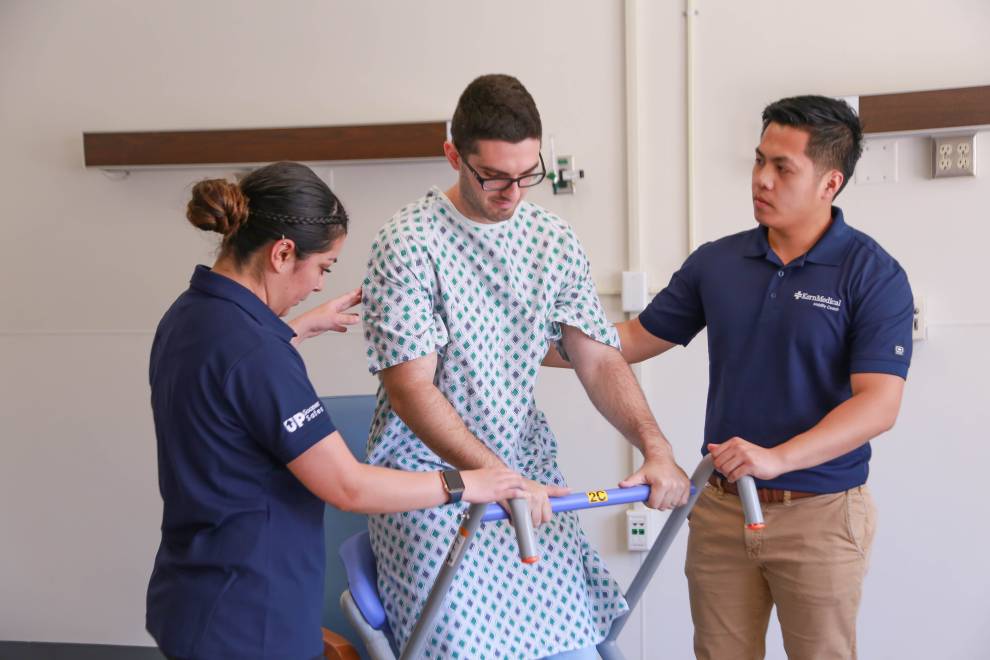
Kern Medical’s Innovative Mobility Program is Making a Difference
When “Joe,” a traumatic brain injury patient at Kern Medical in Bakersfield, fortunately no longer needed mechanical ventilation, he underwent a physical therapy assessment as part of his recovery. The evaluation showed the level of physical support he would need to walk would be too much for a therapist to physically handle due to Joe’s reduced strength and difficulty controlling his own movements.
A partnership between Kern Medical and Kaiser Permanente Southern California to enhance quality of care helped create a solution for Joe and other patients with mobility issues. The Sara Plus is one of many mobility tools Kern Medical bought using Kaiser Permanente grant funding for its new Up Sooner Safer Mobility Program. Using this advanced lift, Joe had enough support to stand with the machine. As a result, the therapist could better assist with moving and guiding Joe’s legs, and Joe could successfully practice walking.
"Our new Up Sooner Safer Mobility Program demonstrates how this innovative work improves quality of life for our community’s most vulnerable patients while also reducing risks to caregivers and patients,” said Toni Smith, MSN, RN-C, chief nursing officer, Kern Medical.
“Research has shown that patients who get out of bed and begin moving sooner, experience better health outcomes, may be discharged more quickly, and suffer fewer hospital-acquired conditions such as falls, pressure ulcers, and pneumonia," said Angela Coron, managing director, Community Health, KPSC. "Moving patients safely is also crucial to preventing caregiver injuries."
Kern Medical and Kaiser Permanente partner to enhance care
Initially, a team of Kern Medical operational leaders met with Cecelia Crawford, DNP, RN, a practice specialist for evidence-based practice and program evaluation in the Regional Nursing Research Program at KPSC. Together they assessed the areas where the public safety net hospital wanted to improve, and how KPSC could help. After deciding a progressive mobility program was needed to improve outcomes of hospitalized patients, the team developed the Up Sooner Safer program based on Kaiser Permanente’s evidence-based, best-practice programs.
A $576,000 community health grant from KPSC in 2016 helped Kern Medical fund the program’s development and implementation, including 64 pieces of new safe patient handling equipment. New mechanical lifting devices were placed throughout the hospital and some clinics. Kern Medical also collaborated with KPSC to provide staff training on the lift equipment and evidence-based mobility protocols.
The program has already helped significantly improve care at Kern Medical. According to the hospital’s latest mobility-related statistics, in 2018:
- Patient falls decreased 52 percent using safe patient handling equipment
- Staff injuries over a 9-month period fell from 11 to 1 injury, which was considered unavoidable – resulting in a 100 percent reduction in avoidable safe patient handling injuries
- Workers’ compensation claims dropped by $300,000
Another improvement is the number of nurses who handled mobility interventions with their patients rather than request a physical therapist to assist, jumped from 10 percent to 64 percent.
“More nurses feel comfortable now doing the mobility interventions,” said Travis Eckard, manager, therapy services, Kern Medical. “With a limited number of physical therapists on staff, this helps allow the therapists to focus on patients with the most challenging mobility issues.”
Additionally, the Hospital Consumer Assessment of Healthcare Providers and Systems – a patient satisfaction survey of adult inpatients required by the Centers for Medicare and Medicaid Services – showed a steady trend upward.
This year, Crawford will facilitate the writing of a manuscript to describe Kern Medical’s program design, implementation, and patient, staff, and organizational outcomes. “The successful adoption of interventions and innovative approaches to improve the quality of health care depends on complete and accurate reporting of quality improvement,” Crawford said. “This increases the likelihood that other health care institutions will be able to use the information in their own settings.”
Check out this short video for more comments from Toni Smith and Travis Eckard at Kern Medical:
To learn more about Kaiser Permanente Southern California’s work in the community, please visit http://community.kp.org.